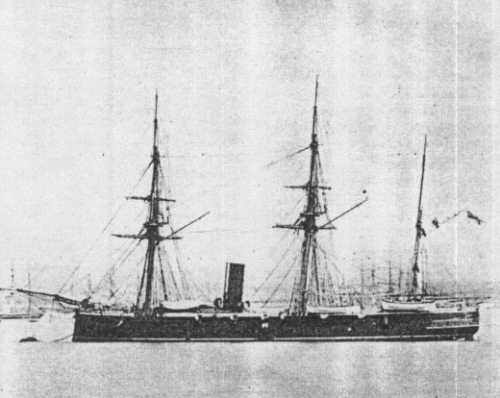
NAVYPEDIA
 Support the project with paypal
Support the project with paypal
Photo

Sirius
Ships
| Name | No | Yard No | Builder | Laid down | Launched | Comp | Fate |
|---|---|---|---|---|---|---|---|
| Danae | Portsmouth DYd | 1865 | 21.5.1867 | 11.1867 | to War Dept 1886 | ||
| Blanche | Chatham DYd | 1865 | 17.8.1867 | 1.1868 | sold 9.1886 | ||
| Eclipse (ex-Sappho) | Sheerness DYd | 1866 | 14.11.1867 | 6.1868 | to War Dept 1888 | ||
| Sirius | Portsmouth DYd | 1867 | 24.4.1868 | 1869 | sold 1885 | ||
| Spartan | Deptford DYd | 1867 | 14.11.1868 | 8.1871 | sold 11.1882 | ||
| Dido | Portsmouth DYd | 1868? | 23.10.1869 | 20.4.1871 | hulk 1886 | ||
| Tenedos | Devonport DYd | 11.11.1867 | 13.5.1870 | 7.1872 | sold 11.1887 |
Technical data
| Displacement normal, t | 1760 |
|---|---|
| Displacement full, t | |
| Length, m | 64.6 pp |
| Breadth, m | 11.0 |
| Draught, m | 4.97 hold depth |
| No of shafts | 1 |
| Machinery | Danae, Blanche: sails + boilers, 1 2-cyl HSE Eclipse: sails + boilers, 1 2-cyl HSE trunk Sirius, Spartan: sails + boilers, 1 4-cyl HC Dido, Tenedos: sails + boilers, 1 2-cyl HC |
| Power, h. p. | Danae: 2089 Blanche: 2158 Eclipse: 1946 Sirius: 2334 Spartan: 1960 Dido: 2518 Tenedos: 2038 |
| Max speed, kts | Danae: 13.2 Blanche: 13.6 Eclipse, Tenedos: 13 Sirius, Spartan: 13.1 Dido: 13.7 |
| Fuel, t | coal |
| Endurance, nm(kts) |
|
| Armament | 2 x 1 - 178/16 MLR Mk III, 4 x 1 - 160/16 64pdr 71cwt MLR |
| Complement | 180 |
Graphics
Project history
Designed by Sir Edward Reed, this class were laid down as ram-bow sloops, and in 1876 upgraded to corvettes. They were similar to the six wooden sloops of the Amazon class, with the same depth and beam, but built 7.6m longer. They were the smallest corvettes to that date in the Victorian Navy. The distinctive feature was the ram bow, which was not for offensive purposes but to obtain additional displacement forward, and as a means of lightening that end of the submerged hull by reversing the angle of slope of the superstructure above it. In all, Reed designed 16 wooden corvettes and sloops with ram bows. Their full lines, extending well towards the extremities, made them tubby little vessels. Except for their iron cross beams they were entirely built of wood, and were copper-sheathed. They had heavy, rounded, battleship-type stems, decorated with false ports but no quarter galleries. The poop and topgallant forecastle projected slightly above the waist bulwarks. There were no embrasures, the gun ports being pierced along the upper deck level. The two slide-mounted 7in guns were carried amidships, and could be pivoted through curved training races to any of four ports, two on either side. The truck-mounted 64pdrs were divided into two at either end of the waist. When a chase gun was needed, one of these guns could be run to ports beneath the poop or the topgallant forecastle. Blanche, Dido, Spartan and Tenedos were ship-rigged; the others were barque-rigged. All had running-in bowsprits. Sirius, Spartan and Tenedos were the first corvettes to receive compound engines. Those in Spartan and Sirius were troublesome. The engine consisted of two HP and two LP cylinders working on one pair of cranks. There was difficulty in maintaining steam pressure due to the distance the HP steam had to pass from the boilers to the HP cylinders. A contributory factor to the unsatisfactory performance was the stokers' inexperience with compound machinery. Tenedos achieved the results sought for, being engined by Elders, the pioneers and foremost builders of marine compound engines. Because a hoisting-screw well interfered with stern fire, three of these ships were fitted with Mangin fixed-blade propellers, ie four narrow blades which, it was thought, would present less drag under sail. The other ships had removable blades necessitating a diver lo remove or replace them, therefore proving quite impractical in any seaway. The performance varied considerably under sail, from 11kts in Eclipse to an exceptional 13.5kts in Blanche. Later in their careers, the ship-rigged vessels were changed into barque-rigged vessels.
Modernizations
1875, Spartan: was re-engined with 1 2-cyl HC (1938hp, 13.2kts)
1876, all: were armed with 12 x 1 - 160/16 64pdr 71cwt MLR
Naval service
No significant events.
 HOME
HOME FIGHTING SHIPS OF THE WORLD
FIGHTING SHIPS OF THE WORLD UNITED KINGDOM
UNITED KINGDOM CRUISERS
CRUISERS ECLIPSE wooden screw sloops (1867-1872)
ECLIPSE wooden screw sloops (1867-1872)
